#Fledgling Turkey Vulture
Text
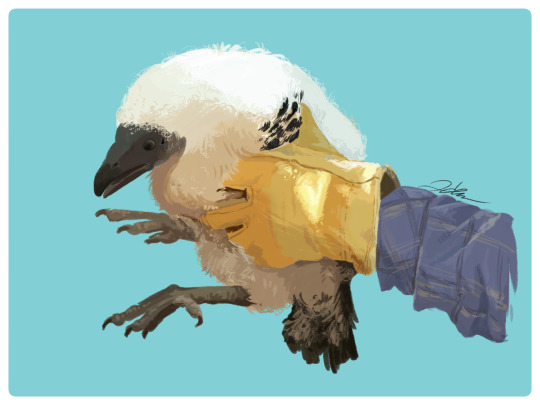
Handling a Fledgling Turkey Vulture for Fat Bird Friday
(Ref used)
» Etsy • Various Links «
© Harlen Chen
#Fledgling Turkey Vulture#turkey vulture#vulture#baby bird#bird#fat bird#fbf#fat bird friday#fluffy#round#borb#chonk#chunk#art#illustration#🐦#burb#birb#digital art#HC#regular content#2023#animal#animals#rotund#la creatura
2K notes
·
View notes
Text
On this Scavenger Sunday we're gonna explore a few species in recognition of yesterday being International Vulture Awareness Day (the first Saturday in September, always).

The California condor is the largest of the North American vultures. After nearly going extinct in the 1980s, their population is rebounding thanks to an extensive captive breeding and release program.
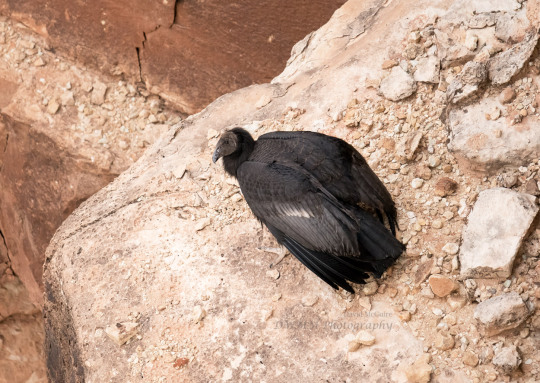
While the wild population of California condors is not self-sustaining yet, there are condors in the wild mating and rearing young. Like this fledgling seen at Navajo Bridge in Arizona. The dark head lightens as the bird ages. Since the population still requires close monitoring, wing-tags will be given when the bird is caught for a medical exam.

A more familiar sight in both North & South America is the condor's smaller cousin, the turkey vulture. The widest ranging of the New World Vultures, this relatively small species is known for using its well-developed sense of smell to locate food that can't be easily seen.

Another relatively small New World Vulture is the American black vulture. Keeping the gray/black skin of all young NWV into adulthood, the white primaries giving their wings an old timey cartoon glove look distinguishes them from the young of their cousins.
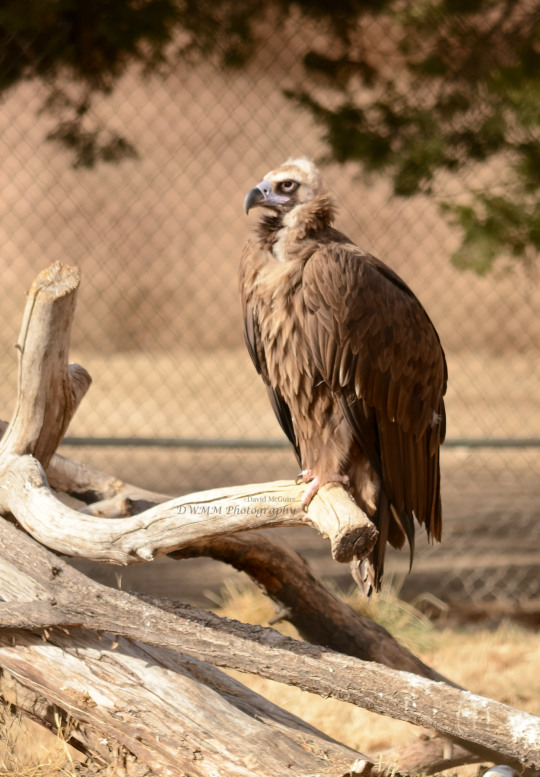
On the other end of the vulture spectrum is the Eurasian black vulture (cinereous vulture). One of the largest Old World Vulture species, these fashionably ruffed individuals are kings of the carcass across their range.
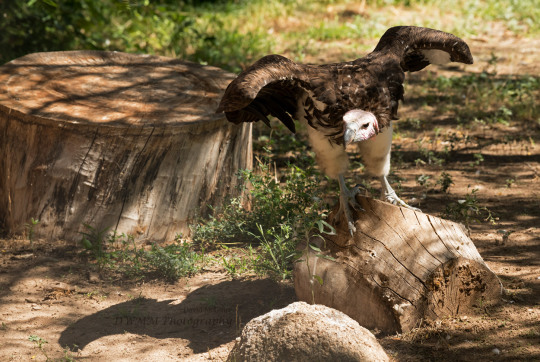
African close cousin to the cinereous vulture is the lappet-faced vulture. Their hefty bill allows them to open carcasses that defeat other species. Their pants are quite fluffy.

Sharing the skies of southern Africa with the lappet-faced vulture is the Cape griffon vulture. Similarly sized to the lappet-faced vulture, these gregarious birds look quite fancy with a bit of rat gut hanging from their mouth.
#my photos#bird photography#zoo photography#sunday is for scavengers#scavenger sunday#vulture#bird#california condor#turkey vulture#black vulture#american black vulture#eurasian black vulture#cinereous vulture#lappet-faced vulture#cape griffon vulture#cape vulture#ivad#ivad 2023#international vulture awareness day#not zoo photography#navajo bridge#vermillion cliffs#Rio Madre de Dios#Peru#Arizona#Pueblo Zoo#Oregon zoo#abqbiopark#bandelier national monument
84 notes
·
View notes
Text
i hope i get shot in the back of the head with a high speed unconventional projectile
ideas for unconventional projectiles: grated parmesan cheese container, empty chip bag (highly compressed), piece of paper folded an impossible number of times, centipede corpse, turkey vulture fledgling, single-packaging pickle w/liquid, mr. wonderful, Wing Chun Canvas Wall Punching Bag (Empty) With 3 Section PU Leather Striking Surface For Kung Fu Training, wing chun canvas wall punching bag (empty) with 3 section PU leather striking surface for kung fu training
W
ing Chun is a form of Chinese martial art where self-defense is the ultimate goal. This type of close range combat requires a tremendous amount of work and persistency. Practicing with this wooden target will improve your skills as well as your patience. In other words, it is not recommended to tape a picture of your boss onto the striking pad.
12 notes
·
View notes
Text
A trail of black feathers--a small personal story of connection

For as long as I can remember, crows in particular have been making themselves known in some capacity in my life. I have vivid childhood memories of the one that got too close-- and I couldn't help but stare with wide eyed mystique. I cannot count the many years later in life where I disregarded such feelings and curiosity about the bird, seemingly forgetting those memories.
Life continued as it were, and life back then had a suffocating heaviness. I had spent my time with an amazing friend. It was during a walk around campus grounds that he looked at me, observed the sky and surrounding area, then stated, "These birds are always around when I hang out with you." I too looked up and around, and there were handful of crows walking around in the near empty lot. A gew flew overhead. They were just crows and not as interesting as the large turkey vulture feather I had just obtained on the path. Or so I believed.
A few weeks later, the same friend and I had met up for lunch. The paneled glass windows of the building showcased a dreary and rainy day. We got our lunch and talked over recent going ons before I casually pointed out the three crows in the tree close to the windows. The words tossed around included everything from "strange" to "coincidental." As the crows sat, my friend guffawed and said,"They're like your spectators."
It was a harmless comment that stuck with me for years after. It was partly the catalyst to what became a deeper understanding and involvement with my inner self. The more I kept an awareness, the more crows I'd find. On the bus, at the stables; around the stores I'd frequent. I would be attentive towards a 'caw', or flying crows above. In times of stress, I would let such sights and sounds of the black bird remind me to take a breath and center myself.
Life eased its burden for a little while, and I found myself closer to the corvids, quite literally. In one instance, I had to let go of pain as a sick crow had died in my arms before any vet could be seen-- the closest I've gotten--but the moment broke my heart.
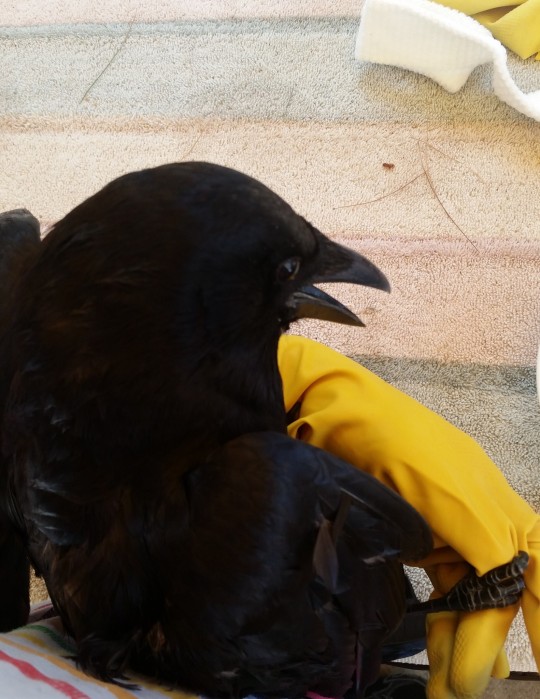
《《°》》
A few years after that event, I briefly befriended a crow pair that made the yard a frequent stop. I got to witness the building of a nest in the pines and seeing fledglings out and about. There were times when the flock would be perched on the broad branches altogether. Each year, crow visitors have been ongoing, and now I finally can appreciate them.
As this chapter opened, my eyes to the sky and ears carefully listening, I've taken it all as a reminder that no matter where I am, crows will be around-- and around me in some way. They are my audience, my "spectators"; an avian that has become more than a symbol to me. They became a bird that whispers into my very spirit.
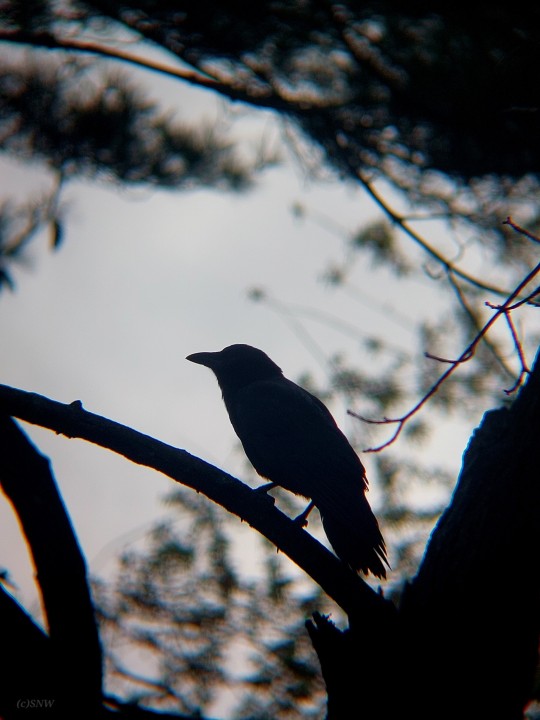
0 notes
Text
Ullante post 4
Name:latrans, better known as Pack Leader
Kingdom:Tundrafrost Empire
Class:dromaeus
Species cross:coyote-dakotaraptor
Age:15
Gender:straight cisgender roo
Size class:large(3 ft 6 in)
Weight class:standard
+:caring, brave, wise, leadership
Neutral:patriotic, ambitious, strict
-:demanding, brutal, blunt
Strengths:high endurance, could keep a steady pace for hours both land and sky. Great senses, can smell and hear a rat from half a mile away. Great leadership.
Weaknesses:not very intelligent, after the bash to the head, he lost some brain function and he wasn't the brightest to begin with. Always puts the pack first to the point where he don't eat as much as he should.
Occupation:pack leader
Likes->
Avus:his pack, avus that don't try to insult his lack of intelligence, the emperor
Food:land meat(mostly whatever the pack catches that day), root vegetables, fish
Other:hunting, coyotes, the moon
Dislikes->
Avus:avus who insult his lack of intelligence or call him stupid, Tuna, anyone who messes with the pack, Ochre
Food:shellfish, fruit, leafy greens
Other:being confused, having things stolen from him, trees
Purchased traits:acquired disability(got hit really hard on the head and suffers brain damage), mange, scars on his face(torn left ear, part of his cheek-lip ripped off, several scratches), 7 pet coyotes
Voice claim:don't have a voice actor. Has a extremely raspy, gravelly, high-pitched voice thats distorted and strained
Family->
Lupus:mother, loves, don't see as often as he'd like do to his pack duties:hunter/butcher:hyenadon-dakotaraptor
Timber:father, loved, misses, deceased:former soldier of the Tundrafrost Empire:coyote-golden eagle
Other->
His packmates:loves, cares for, respects
Ochre:dislikes, often steals hunts from his pack and has fought him before:hunter/tanner:Chasmaporthetes-xenoraptor osteophagus*
Tuna:hates, he was the one who bashed him over the head, cursing him to eternal confusion, hasn't seen him since they fought 7 years ago but when the time comes, Pack Leader'll have his revenge:Sergeant:chacma baboon-bearded vulture
Hailstorm:friend, likes, respects, wishes they were part of the pack, he sometimes trades them wild ingredients for whale meat:whaler apprentice, heir to throne:thylacosmilus-barbarovenator robustus*
Name:Tuna, better known as Jack(he had a pet jack donkey he loved very much as a fledgling)
Kingdom:Eastern Empire
Class:harpy
Species cross:chacma baboon-bearded vulture
Age:12
Gender:cisgender pan roo
Size class:medium(2 ft 6 in)
Weight class:standard
+:strategical, brave, helpful
Neutral:ambitious, goal-driven, never-stopping
-:brutal, merciless, impatient
Strengths:strong, very strong, he could lift triple his own weight and not break a sweat. Great fighter, his superstrength, baboons fangs with the pointed beak, and his extensive training make him a living weapon. Great armor maker, he makes his own excellent armor
Weaknesses:relies too much on his strength, if he were to lose it, he'd be helpless. Clumsy, often breaks things on accident.
Occupation:Sergeant
Likes->
Avus:his family, his army buddies
Food:stews, fish, lean meats, leafy greens
Other:training young'ns, fighting, using his strength
Dislikes->
Avus:Pack Leader, most dromaeus, whiners
Food:greasy food, fatty meats, sour fruit
Other:the dark, fishing, sitting still
Purchased traits/items:iron bostaff(stole from a dromaeus). bronze helmet and chestplate. Padded fabric backplates with leather shingles on top. Superpower, specifically superstrength
Voice claim:don't have a voice actor, sounds like Locustpine but with a deeper voice
Family->
Oak:father, loved, misses, dead:former king:Nothosimius peterjacksonii*-bearded vulture
Coelacanth:mother, loved, misses, dead:former royal consort and advisor:gelada baboon-California condor
King Locustpine:brother, respects and loves:monarch:Nothosimius peterjacksonii*-California condor
Barracuda:adopted brother, loves and respects:General and spy:mandrill-turkey vulture
Willow:sister, loves and respects, worries for:rock/country music star:gelada baboon-bearded vulture
Evergreen:sibling, loves and respects:royal guard:Nothosimius peterjacksonii*-Andean condor
Salt:sister in-law, respects very much:royal consort and general:chimpanzee-harpy eagle
Paprika:nephew, loves, sometimes trains for combat:heir to the throne:Nothosimius peterjacksonii*-harpy eagle
Dogwood:niece, loves, sometimes helps her train for combat:heir to the throne:chimpanzee-california condor
Other->
Pack Leader:hates, once fought in battle:pack leader:coyote-dakotaraptor
Rot:likes, friends:soldier:Cuban solenodon-hooded pitohui
His soldiers:loves, respects
0 notes
Text
I wonder if they think.
I wonder if they think.
The critters are beginning to populate the slough after what seems like was an extra long nesting season. I saw a fledgling Turkey Vulture early this morning and it seemed to be flying well in the wind. The Terns were active as well, I was fortunate to be able to take a few pictures.
They are fast birds by any standards but in the wind it is accelerated by what seems to be many times. As they…

View On WordPress
0 notes
Text
Meet Us in the Meadow
As an intern on the Natural Lands team, I helped prepare for our “Meet Us in the Meadow” event that occurs in late summer/early autumn every year with different activities for our guests to enjoy, all happening throughout our Meadow Garden. My team helped prepare by planting along our current path revitalization project (all native plugs, of course), mulching the beds near the Meadow Garden entrance, raking out and pruning back vines along the paths, and more! It was exciting to see how much work went into this event within just one of the teams, and it was very humbling to experience just how much could get done with the help of so many hands, many of which were volunteers!
Throughout the day itself, I assisted Longwood’s Bluebird Team at the nestbox and bird monitoring display table. Here, we explained the bird program to guests which consists of about 200 nestboxes housing Eastern Bluebirds, Tree Swallows, House Wrens, and Carolina Chickadeeds. The boxes are monitored weekly by 7 volunteers. The program is about 25 years old now and banding of bluebird fledglings has occurred the last two years with about 130 birds having been banded each year! We chatted with guests about why it is important that we have these nestboxes, how to identify different inhabitants, and how to keep out intruders like our invasive foe, the House Sparrow. All in all, it was a great opportunity to discuss these incredible organisms and to pass knowledge across both ends of the table!

One of our display boxes which contains a Carolina Chickadee nest, made of moss, on the bottom, and a House Wren nest built over top of it out of sticks and pine needles. Unfortunately, this is not an uncommon occurrence; however, both species are native and protected.

Although the morning was sunny, winds quickly picked up, blowing in clouds and making for perfect hawk watching conditions! A good thing for our Hawk Watching station! Along with multiple Red-tailed Hawk and Black and Turkey Vulture sightings, we also saw Bald Eagles and an epic battle between a foraging juvenile Northern Harrier and a territorial Cooper’s Hawk! The juvenile Harrier was easily differentiated from the Cooper’s by its much larger size, bright chestnut-colored chest, and white rump.

Just part of the beautiful and well deserved view awaiting guests as they reached the Webb Farm House at the top of the Meadow.

Our nestbox and bird monitoring display table at the Webb Farm House. Large photos (from left to right) show: Eastern Bluebirds hatching; approx. 2-3-day-old nestling bluebirds; an adult Tree Swallow in a crowded nest with its young; a Carolina Chickadee nest with eggs; a banded Eastern Bluebird; and another Eastern Bluebird.
Photos and article by Meredith Hudson, Natural Lands intern
#Longwood Gardens#longwoodstudents#longwood students#students#student#natural lands#webb farmhouse#meet us in the meadow#meadow garden#meadow#event#birds#hatching#hawk#bird watching#nestbox#nature#native#native plants#native species
1 note
·
View note
Text
important information you definitely need
alpaca: a group of alpacas is called a herd and a baby alpaca is called a cria
antelope: a group of antelopes is called a herd and a baby antelope is called a calf
ape: a group of apes is called a shrewdness and a baby ape is called a baby or infant
baboon: a group of baboons is called a troop and a baby baboon is called an infant
badger: a group of badgers is called a cete and a baby badger is called a cup or kit
bat: a group of bats is called a colony and a baby bat is called a pup
bear: a group of bears is called a sleuth and a baby bear is called a cub
bee: a group of bees is called a colony, swam or hive and a baby bee is called a larva or pupa
beluga: a group of belugas is called a pod and a baby beluga is called a calf
buffalo: a group of buffalos is called a herd and a baby buffalo is called a calf
camel: a group of camels is called a caravan or flock and a baby camel is called a calf
cat: a group of cats is called a clowder and a baby cat is called a kitten
cattle/cow: a group of cows is called a herd and a baby cow is called a calf
cheetah: a group of cheetahs is called a coalition and a baby cheetah is called a cub
chicken: a group of chickens is called a flock and a baby chicken is called a chick
crocodile: a group of crocodiles is called a congregation or float and a baby crocodile is called a hatchling
crow: a group of crows is called a murder and a baby crow is called a chick
deer: a group of deers is called a herd and a baby deer is called a fawn
dog: a group of dogs is called a pack and a baby dog is called a puppy or pup
dolphin: a group of dolphins is called a pod and a baby dolphin is called a calf
donkey: a group of donkeys is called a herd and a baby donkey is called a foal
duck: a group of ducks is called a flock or bunch and a baby duck is called a duckling
eagle: a group of eagles is called a convocation and a baby eagle is called a fledgling
elephant: a group of elephants is called a herd or a parade and a baby elephant is called a calf
emu: a group of emus is called a mob and a baby emu is called a chick or hatchling
falcon: a group of falcons is called a cast and a baby falcon is called a chick
ferret: a group of ferrets is called a business and a baby ferret is called a kit
fish: a group of fish is called a school and a baby fish is called a fry
fox: a group of foxes is called a lead or skulk and a baby fox is called a cub or kit
frog: a group of frogs is called an army and a baby frog is called a tadpole or froglet
giraffe: a group of giraffes is called a herd and a baby giraffe is called a calf
goat: a group of goats is called a herd and a baby goat is called a kid
goose: a group of goose is called a flock or gaggle and a baby goose is called a gosling
gorilla: a group of gorillas is called a band and a baby gorilla is called an infant
hamster: a group of hamsters is called a horde and a baby hamster is called a pup
hare: a group of hares is called a warren and a baby hare is called a leveret
hedgehog: a group of hedgehogs is called an array and a baby hedgehog is called a pup or piglet
hippo: a group of hippos is called a pod or float and a baby hippo is called a calf
horse: a group of horses is called a stud, drove or stable and a baby horse is called a foal
hyena: a group of hyenas is called a clan and a baby hyena is called a cub or pup
jellyfish: a group of jellyfish is called a swarm or bloom and a baby jellyfish is called an ephyna
kangaroo: a group of kangaroos is called a court or a troop and a baby kangaroo is called a joey
koalas: a group of koalas is technically called a colony, but koalas are solitary and a baby koala is called a joey
lark: a group of larks is called an exaltation and a baby lark is called a chick
lemur: a group of lemurs is called a congress or a conspiracy and a baby lemur is called an infant
leopard: a group of leopards is called a leap and a baby leopard is called a cub
lion: a group of lions is called a pride and a baby lion is called a cub
llama: a group of llamas is called a herd or flock and a baby llama is called a cria
manatee: a group of manatees is called an aggregation and a baby manatee is called a calf
meerkat: a group of meerkat is called a mob and a baby meerkat is called a pup
mole: a group of moles is called a labour and a baby mole is called a pup
monkey: a group of monkeys is called a troop and a baby monkey is called an infant
moose: a group of moose is called a herd and a baby moose is called a calf
mouse: a group of mice is called a colony or horde and a baby mouse is called a pup or kitten
narwhal: a group of narwhal is called a blessing and a baby narwhal is called a calf
opossum: a group of opossums is called a passel and a baby opossum is called a joey
ostrich: a group of ostriches is called a flock and a baby ostrich is called a chick
otter: a group of otters is called a family or raft and a baby otter is called a whelp or pup
owl: a group of owls is called a parliament and a baby owl is called a fledgling
oyster: a group of oysters is called a bed and a baby oyster is called a spat
panda: a group of pandas is called a sleuth and a baby panda is called a cub
peacock: a group of peacocks is called an ostentation and a baby peacock is called a peachick
pelican: a group of pelican is called a pod and a baby pelican is called a chick
penguin: a group of penguins is called a rookery and a baby penguin is called a chick
pig: a group of pigs is called a drove and a baby pig is called a piglet
platypus: a group of platypuses does not have a name (sad face) and a baby platypus is called a puggle
polar bear: a group of polar bears is called a celebration and a baby polar bear is called a cub
porcupine: a group of porcupine is called a prickle and a baby porcupine is called a pup
rabbit: a group of rabbits is called a colony or warren and a baby rabbit is called a kit or bunny
raccoon: a group of raccoons is called a nursery and a baby raccoon is called a cub
rat: a group of rats is called a colony, pack, or plague and a baby rat is called a kitten or pup
raven: a group of ravens is called an unkindness and a baby raven is called a chick
red panda: a group of red panda is called a pack and a baby red panda is called a cub
rhinoceros: a group of rhinos is called a crash and a baby rhino is called a calf
salmon: a group of salmon is called a run and a baby salmon is called a par
sea horse: a group of sea horse is called a shoal and a baby sea horse is called a foal
seal: a group of seals is called a pod and a baby seal is called a pup
shark: a group of sharks is called a school or shiver and a baby shark is called a pup
sheep: a group of sheep is called a flock and a baby sheep is called a lamb
snake: a group of snakes is called a nest and a baby snake is called a snakelet
spider: a group of spiders is called a cluster and a baby spider is called a spiderling
squid: a group of squid is called a shoal or audience and a baby squid is called a hatchling
squirrel: a group of squirrels is called a dray and a baby squirrel is called a pup or kit
swan: a group of swans is called a team or herd and a baby swan is called a cygnet
tiger: a group of tigers is called an ambush and a baby tiger is called a cub
turkey: a group of turkeys is called a rafter and a baby turkey is called a poult
turtle: a group of turtle is called a bale and a baby turtle is called a hatchling
vulture: a group of vultures is called a venue and a baby vulture is called a chick
walrus: a group of walrus is called a herd or pod and a baby walrus is called a pup
whale: a group of whales is called a pod or herd and a baby whale is called a calf
wolf: a group of wolves is called a pack and a baby wolf is called a pup or whelp
wombat: a group of wombats is called a mob and a baby wombat is called a joey
yak: a group of yak is called a herd and a baby yak is called a calf
zebra: a group of zebra is called a herd and a baby zebra is called a foal or colt
14 notes
·
View notes
Text

👖 Young Turkey Vulture on Weary Bird Wednesday
(ref used)
» Etsy • Various Links «
© Harlen Chen
#turkey vulture#fledgling#baby#baby turkey vulture#vulture#buzzard#pants#weary#weary bird wednesday#bird#fat bird#wbw#fluffy#round#borb#chonk#chunk#art#illustration#🐦#burb#birb#digital art#HC#regular content#2023#animal#animals#rotund
34 notes
·
View notes